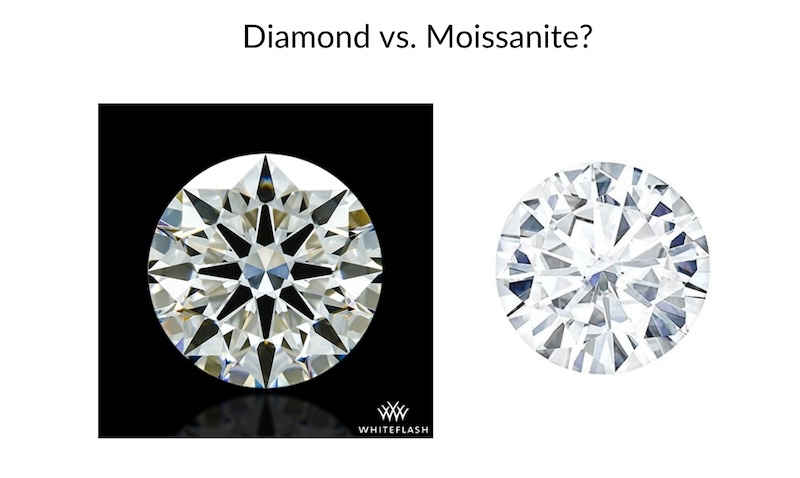In the quest for the perfect gemstone, two sparkling contenders have captured the attention of modern consumers: lab-grown diamonds and moissanite. Both offer unique advantages and share the spotlight in today’s jewelry market for those seeking beauty, sustainability, and value. Lab-grown diamonds, known for their identical characteristics to naturally mined diamonds, promise the allure of perfection without the hefty price tag and ethical concerns associated with traditional diamond mining. Moissanite, a gem born from the stars, offers a more affordable alternative with its own distinctive sparkle and impressive durability. This guide will delve into the critical differences between these two gemstones, helping you understand why lab-grown diamonds might just be the superior choice for discerning buyers who seek both luxury and responsibility in their jewelry investments.
Composition and Appearance: Lab Grown vs. Moissanites
Lab-Grown Diamonds
Lab-grown diamonds, scientifically identical to natural diamonds, are crafted through meticulous processes that replicate the natural formation of diamonds under the earth. Here are some specific characteristics:
- Chemical Composition: Pure carbon, crystallized in isotropic 3D form.
- Manufacturing Processes: Mainly involves Chemical Vapor Deposition (CVD) and High Pressure High Temperature (HPHT) methods. These methods allow precise control over the diamond’s growth environment, enhancing the quality of the resulting gemstones.
- Visual Qualities:
- Clarity: Often possesses fewer inclusions and blemishes due to controlled growth conditions.
- Color: Can range from colorless to varying shades, which are determined and controlled during the growth process.

This Laboratory Grown Diamond was created by High Pressure High Temperature (HPHT) growth process Type II
Moissanite
Moissanite, initially found in meteorites, is composed of silicon carbide—a material that bestows unique qualities upon the gemstone. Here’s a detailed look at its specific characteristics:
- Chemical Composition: Silicon carbide, different from diamonds’ carbon composition, giving it distinct thermal and optical properties.
- Optical Properties:
- Brilliance: Exhibits a fiery, rainbow-like sparkle that exceeds a diamond’s, due to higher light dispersion.
- Hardness: Rated at 9.25 on the Mohs scale, making it one of the hardest substances on Earth, though slightly less than diamonds.
- Refractive Index: Higher than diamond’s, contributing to its greater brilliance and fire.
The stark differences in composition and appearance between lab-grown diamonds and moissanite are not just in price but also in the intrinsic properties that affect their aesthetics and performance in jewelry. These distinctions help guide consumers in choosing a gemstone that aligns with their preferences for sparkle, budget, and ethical considerations.
Before making your choice of where to buy lab-grown diamonds, I highly recommend exploring my detailed reviews on Whiteflash, Brilliant Earth, and James Allen. These insights will equip you with the necessary knowledge to make an informed decision, ensuring you select the best option that aligns with your preferences and values.
Can You Tell the Difference Between a Lab Diamond and Moissanite?
Distinguishing between a lab-grown diamond and moissanite can be challenging without the proper knowledge and tools, as both gemstones are visually similar and exhibit high levels of brilliance and clarity. However, there are subtle differences that can help identify each. Here are key aspects to look out for when comparing these two stones side by side:

Refractive Properties
- Lab-Grown Diamond: Exhibits a singular refraction of light, meaning light passes through and exits as a single ray, contributing to its unique sparkle. This gives diamonds their characteristic “fire” or dispersion of light into the colors of the spectrum, which is more subdued compared to moissanite.
- Moissanite: Displays double refraction, where light entering the stone splits into two rays. This results in a more pronounced rainbow effect in its sparkle, which can be a giveaway under certain lighting conditions.
Hardness and Scratch Resistance
- Lab-Grown Diamond: With a hardness of 10 on the Mohs scale, diamonds are the hardest known mineral and are highly resistant to scratching. This feature is paramount in distinguishing them from moissanite in durability tests.
- Moissanite: Slightly less hard at 9.25 on the Mohs scale. While still very durable, moissanite may be slightly more prone to acquiring surface marks under extreme conditions compared to diamonds.
Thermal Conductivity
- Lab-Grown Diamond: Diamonds are excellent conductors of heat. Professional jewelers often use thermal conductivity testers to differentiate diamonds from other gemstones, including moissanite.
- Moissanite: Has different thermal conductivity properties compared to diamonds, which can be detected with a thermal conductivity tester commonly used by jewelers.
Price and Size
- Price Comparison: Moissanite is generally much less expensive than lab-grown diamonds of similar size and appearance, which can be a clue if pricing information is available.
- Size Perception: Because moissanite is less dense, it often appears larger than a diamond of the same carat weight. This can be noticeable when comparing two stones of supposed equal carat size.
By examining these characteristics, especially when you have the stones side by side, you can become more adept at distinguishing between lab-grown diamonds and moissanite. For those considering a purchase, it may be beneficial to view the gemstones under different lighting conditions and consult with a trusted jeweler who can utilize specialized tools for a more definitive identification.
Cost Comparison: Lab Grown vs. Moissanites
When choosing between lab-grown diamonds, moissanite, and natural diamonds, cost is often a decisive factor. Here’s a detailed breakdown of the pricing for each option:
Lab-Grown Diamonds
- Price Range: Typically, a 1-carat lab-grown diamond costs between $700 and $2,000. This price variability is largely dependent on factors such as cut, color, clarity, and the specific technology used in the creation process (CVD vs. HPHT).
- Volatility: The prices of lab-grown diamonds can be volatile, influenced by technological advancements and market demand. However, they consistently remain less expensive than their natural counterparts while offering comparable quality and aesthetics.
Moissanite
- Consistent Pricing: Moissanite remains the most budget-friendly option, with a 1-carat stone priced around $400. This price stability makes moissanite an attractive choice for those seeking affordability without compromising on the gemstone’s visual appeal.
- Value: Offers significant savings over both natural and lab-grown diamonds, with a brilliance and fire that are distinct and appealing in their own right.
Natural Diamonds
- Price Range: The cost for a 1-carat natural diamond ranges dramatically from about $1,800 to $17,000, dictated by the gemstone’s quality, rarity, and the traditional costs associated with mining and distribution.
- Premium for Rarity: The higher prices of natural diamonds reflect not just their physical and aesthetic qualities but also their perceived rarity and the traditional allure associated with naturally mined stones.
Comparative Analysis
- Affordability: Both moissanite and lab-grown diamonds present more affordable alternatives to natural diamonds, with lab-grown options providing a middle path in terms of cost and authenticity.
- Quality vs. Cost: Lab-grown diamonds and moissanite offer high-quality alternatives at significantly reduced prices. For those who value the ethical and environmental aspects alongside cost, lab-grown diamonds strike an ideal balance between quality and sustainability.
Understanding the importance of diamond cut is crucial as it directly influences the stone’s brilliance and overall aesthetic appeal. Additionally, delve into our guide on light performance images to see how different cuts impact a diamond’s interaction with light, providing you with a visual understanding of what makes each diamond unique. Finally, don’t overlook the significance of proper certification, which ensures that your choice meets the highest standards of quality and authenticity. Armed with this knowledge, you’ll be well-equipped to select a diamond that not only meets but exceeds your expectations.
Durability and Care: Lab Grown vs. Moissanites
Choosing a gemstone isn’t just about beauty and cost—it’s also about durability and ease of care. Here’s how lab-grown diamonds and moissanite stack up in these areas:
Lab-Grown Diamonds
- Durability: Lab-grown diamonds are rated a 10 on the Mohs scale of mineral hardness, which is the highest possible rating. This makes them exceptionally durable and resistant to scratches and abrasions, ideal for everyday wear.
- Care: Caring for lab-grown diamonds is straightforward and similar to that of natural diamonds. Regular cleaning with a soft brush and soapy water, or a commercial jewelry cleaner, is sufficient to maintain their sparkle and brilliance. They can also be taken to a professional jeweler for periodic steam cleaning or ultrasonic cleaning, which can help remove built-up residue and ensure the diamond’s setting remains secure.
Moissanite
- Hardness: Moissanite comes close to diamonds in terms of hardness, scoring a 9.25 on the Mohs scale. This makes it highly durable and suitable for daily wear, although it is slightly more prone to scratches compared to diamonds.
- Care Tips:
- Regular Cleaning: To maintain the stunning luster of moissanite, clean it regularly using a solution of mild soap and warm water. Use a soft toothbrush to gently scrub the stone, especially under the setting where dirt can accumulate.
- Avoid Harsh Chemicals: While moissanite is resistant to many chemicals, it’s best to avoid exposure to harsh chemicals that can dull its surface. Remove your moissanite jewelry during activities that may expose it to chemicals such as swimming or cleaning.
- Professional Check-Ups: It’s a good idea to have your moissanite jewelry checked by a professional jeweler once a year to ensure the setting is secure, particularly for pieces that are worn frequently.
Both lab-grown diamonds and moissanite offer excellent durability, making them suitable for engagement rings and other jewelry intended for daily wear. Their care routines ensure that these gemstones can last a lifetime, looking as brilliant as the day they were bought with minimal effort.
Where to Buy Lab Diamonds & Moissanites
When it comes to purchasing lab-grown diamonds or moissanite, selecting the right retailer is crucial. Here are some recommended places to buy each, ensuring quality, value, and customer service.
Lab-Grown Diamonds
- Whiteflash: Known for their exceptional quality and service, Whiteflash offers a selection of lab-grown diamonds through their Precision Lab. This collection features expertly crafted diamonds with a focus on high precision and performance.
- Brilliant Earth: A leader in ethically sourced fine jewelry, Brilliant Earth provides a wide range of lab-grown diamonds. They are known for their commitment to environmental responsibility and ethical practices, making them a popular choice for conscious consumers.
- James Allen: Offering a comprehensive and user-friendly online experience, James Allen allows customers to customize their lab-grown diamond jewelry. Their high-resolution imagery and 360-degree videos help buyers see exactly what they are purchasing.
Moissanite
- Brilliant Earth: Also a prime destination for moissanite, Brilliant Earth offers a variety of styles and settings, catering to those who prefer this more affordable yet brilliant alternative.
- Charles & Colvard: As pioneers in creating moissanite, Charles & Colvard offer some of the highest quality moissanite available on the market. Their gems are known for their durability, brilliance, and near-colorless appearance.
- James Allen: Known for their detailed customization and extensive collection, James Allen also provides a selection of high-quality moissanite. This makes them a great choice for those looking for both traditional and contemporary designs in moissanite jewelry.
Whether you are in the market for a lab-grown diamond or moissanite, these retailers provide trustworthy and high-quality options. Each offers unique benefits, from sustainable and ethical practices to customization and innovative designs, ensuring there’s something for every taste and budget.

